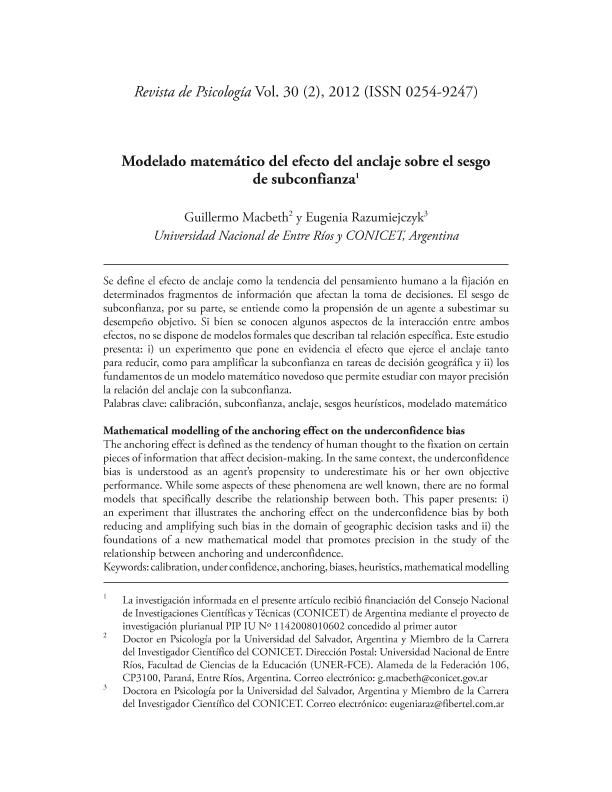Mostrar el registro sencillo del ítem
dc.contributor.author
Macbeth, Guillermo Eduardo

dc.contributor.author
Razumiejczyk, Eugenia

dc.date.available
2023-06-07T15:56:02Z
dc.date.issued
2012-12
dc.identifier.citation
Macbeth, Guillermo Eduardo; Razumiejczyk, Eugenia; Modelado matemático del efecto del anclaje sobre el sesgo de subconfianza; Pontificia Universidad Católica del Perú; Revista de Psicología; 30; 2; 12-2012; 223-248
dc.identifier.issn
0254-9247
dc.identifier.uri
http://hdl.handle.net/11336/199837
dc.description.abstract
Se define el efecto de anclaje como la tendencia del pensamiento humano a la fijación en determinados fragmentos de información que afectan la toma de decisiones. El sesgo de subconfianza, por su parte, se entiende como la propensión de un agente a subestimar su desempeño objetivo. Si bien se conocen algunos aspectos de la interacción entre ambos efectos, no se dispone de modelos formales que describan tal relación específica. Este estudio presenta: i) un experimento que pone en evidencia el efecto que ejerce el anclaje tanto para reducir, como para amplificar la subconfianza en tareas de decisión geográfica y, ii) los fundamentos de un modelo matemático novedoso que permite estudiar con mayor precisión la relación del anclaje con la subconfianza.
dc.description.abstract
The anchoring effect is defined as the tendency of human thought to the fixation on certain pieces of information that affect decision-making. In the same context, the underconfidence bias is understood as an agent’s propensity to underestimate his or her own objective performance. While some aspects of these phenomena are well known, there are no formal models that specifically describe the relationship between both. This paper presents: i) an experiment that illustrates the anchoring effect on the underconfidence bias by both reducing and amplifying such bias in the domain of geographic decision tasks and ii) the foundations of a new mathematical model that promotes precision in the study of the relationship between anchoring and underconfidence.
dc.format
application/pdf
dc.language.iso
spa
dc.publisher
Pontificia Universidad Católica del Perú
dc.rights
info:eu-repo/semantics/openAccess
dc.rights.uri
https://creativecommons.org/licenses/by-nc-sa/2.5/ar/
dc.subject
CALIBRACIÓN
dc.subject
SUBCONFIANZA
dc.subject
ANCLAJE
dc.subject
SESGOS
dc.subject
HEURÍSTICOS
dc.subject
MODELADO
dc.subject.classification
Psicología

dc.subject.classification
Psicología

dc.subject.classification
CIENCIAS SOCIALES

dc.title
Modelado matemático del efecto del anclaje sobre el sesgo de subconfianza
dc.title
Mathematical modelling of the anchoring effect on the underconfidence bias
dc.type
info:eu-repo/semantics/article
dc.type
info:ar-repo/semantics/artículo
dc.type
info:eu-repo/semantics/publishedVersion
dc.date.updated
2023-06-06T13:24:17Z
dc.journal.volume
30
dc.journal.number
2
dc.journal.pagination
223-248
dc.journal.pais
Perú

dc.journal.ciudad
Lima
dc.description.fil
Fil: Macbeth, Guillermo Eduardo. Universidad Nacional de Entre Ríos; Argentina. Consejo Nacional de Investigaciones Científicas y Técnicas; Argentina
dc.description.fil
Fil: Razumiejczyk, Eugenia. Consejo Nacional de Investigaciones Científicas y Técnicas; Argentina. Universidad Nacional de Entre Ríos; Argentina
dc.journal.title
Revista de Psicología
dc.relation.alternativeid
info:eu-repo/semantics/altIdentifier/url/http://pepsic.bvsalud.org/scielo.php?script=sci_arttext&pid=S0254-92472012000200001
Archivos asociados
